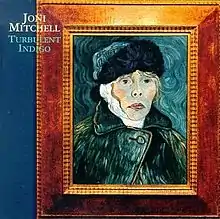Turbulent Indigo
Turbulent Indigo is the 15th album by Canadian singer-songwriter Joni Mitchell. Released in 1994, it won a Grammy Award for Pop Album of the Year. John Milward, writing for Rolling Stone, wrote that it was Mitchell's "best album since the mid-'70s".[6]
| Turbulent Indigo | ||||
|---|---|---|---|---|
 | ||||
| Studio album by | ||||
| Released | October 25, 1994 | |||
| Recorded | 1993 | |||
| Genre | Adult alternative | |||
| Length | 43:02 | |||
| Label | Reprise | |||
| Producer | Joni Mitchell, Larry Klein | |||
| Joni Mitchell chronology | ||||
| ||||
| Review scores | |
|---|---|
| Source | Rating |
| Allmusic | |
| Los Angeles Times | |
| Q | |
| Entertainment Weekly | B+ |
| Rolling Stone | |
| Robert Christgau | |
The album marked her return to Warner Music (formerly WEA) distribution after her previous album, Night Ride Home, was distributed by MCA for its then-newly purchased subsidiary Geffen Records (which, prior to the sale to MCA, had distributed through WEA).
The album takes inspiration from the Dutch artist Vincent van Gogh for Mitchell's self-portrait on the cover. The song "Turbulent Indigo" references Van Gogh, while the song "Magdalene Laundries" recounts the sufferings of Irish women once consigned to Magdalen Asylums run by the Roman Catholic Church and made to work in the asylum's laundries. The song "Not to Blame" was rumored to be about Mitchell's singer-songwriting colleague Jackson Browne who was alleged to have beaten his girlfriend, actress Daryl Hannah; Mitchell denies this. . The song "Sex Kills" referenced a number of late 20th century topical issues, including violence, AIDS, global warming and consumerism.
As of December 2007, the album has sold 311,000 copies in the US.[7]
Track listing
All tracks composed by Joni Mitchell; except where indicated
- "Sunny Sunday" – 2:21
- "Sex Kills" – 3:56
- "How Do You Stop" – 4:09 (Charlie Midnight, Dan Hartman)
- "Turbulent Indigo" – 3:34
- "Last Chance Lost" – 3:14
- "The Magdalene Laundries" – 4:02
- "Not to Blame" – 4:18
- "Borderline" – 4:48
- "Yvette in English" – 5:16 (Mitchell, David Crosby)
- "The Sire of Sorrow (Job's Sad Song)" – 7:08
Personnel
- Joni Mitchell – vocals, guitar, keyboards
- Larry Klein – organ, bass
- Wayne Shorter – soprano saxophone on tracks: 1, 4, 7, 8, 10
- Jim Keltner – drums on "Sunny Sunday"
- Carlos Vega – drums on tracks: 3, 4, 7
- Michael Landau – electric guitar on tracks: 2, 3
- Greg Leisz – pedal steel guitar on tracks: 7, 8
- Steuart Smith – guitar on "How Do You Stop"
- Seal – vocals on "How Do You Stop"
- Bill Dillon – synthesizer on "Yvette in English"
- Charles Valentino – backing vocals on "Yvette in English"
- Kris Kello – backing vocals on "Yvette in English"
Reception
"A welcome return to the atmospherics and acoustic terrain she's best known for," wrote Q's Tom Doyle. "The majority of the tracks here recall the wafting soundscapes of 1976's Hejira, with gentle, controlled feedback, Pastorius-styled bass, Wayne Shorter's tumbling sax patterns and walls of acoustic guitars providing a dramatic backdrop for Mitchell's bold lyrical imagery."[8]
Notes
- Ruhlmann, W. (2011). "Turbulent Indigo – Joni Mitchell | AllMusic". allmusic.com. Retrieved July 19, 2011.
- Willman, Chris (2011). "Album Review – Los Angeles Times". articles.latimes.com. Retrieved July 19, 2011.
- Q, December 1994
- Milward, John (2011). "Joni Mitchell: Turbulent Indigo : Music Reviews : Rolling Stone". web.archive.org. Archived from the original on January 24, 2009. Retrieved July 19, 2011.CS1 maint: unfit URL (link)
- Symbol means that one cut ("Last Chance Lost") is good but album is not worth the time or money. Christgau, R. (2011). "Robert Christgau: CG: joni mitchell". robertchristgau.com. Retrieved July 19, 2011.
- John Milward (December 15, 1994). "Rolling Stone magazine". Retrieved February 11, 2012.
- Caulfield, Keith (December 21, 2007). "Ask Billboard". Billboard. Retrieved May 19, 2018.
- Q, December 1994